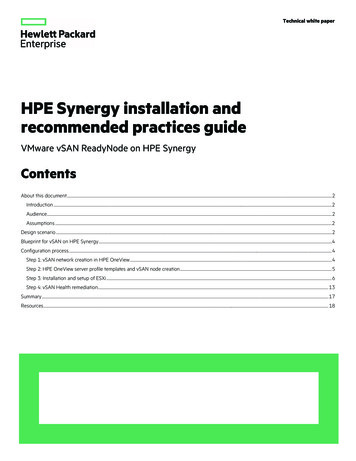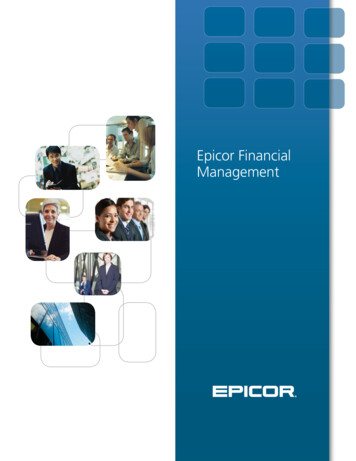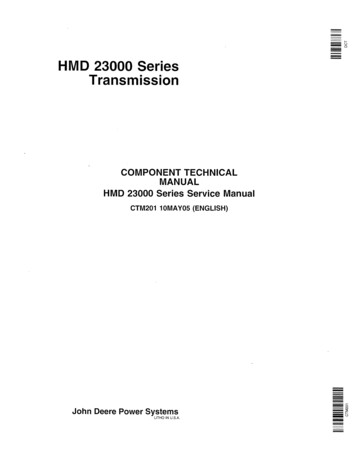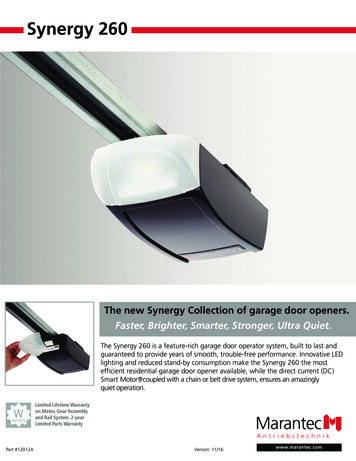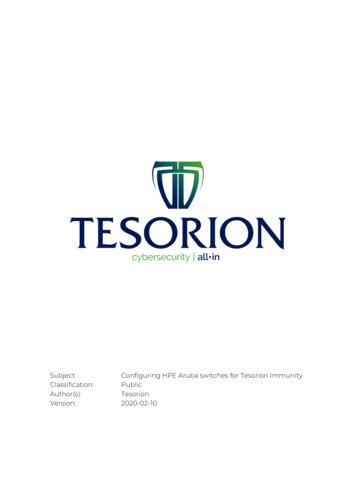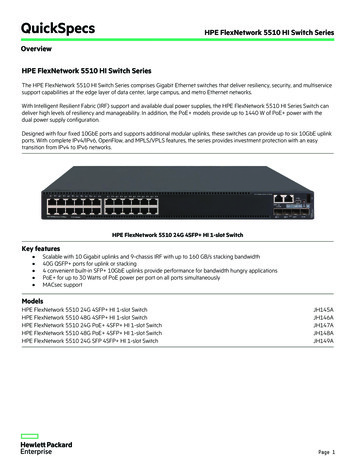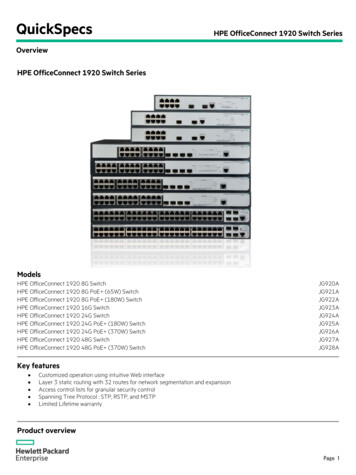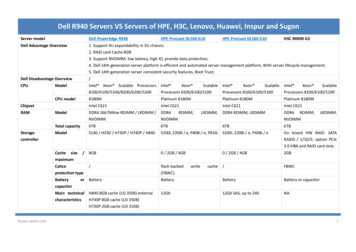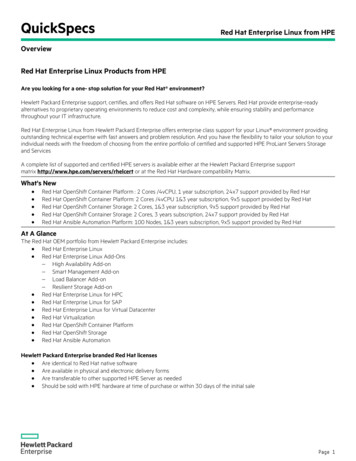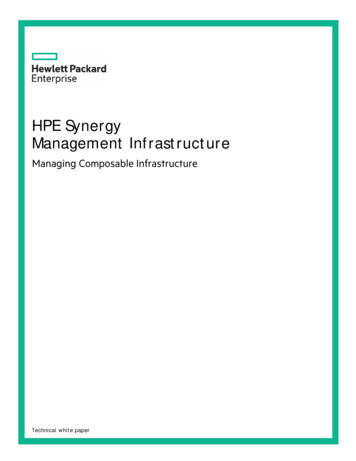
Transcription
HPE SynergyManagement InfrastructureManaging Composable InfrastructureTechnical white paper
Technical white paperContentsIntroduction .3HPE Synergy is Composable Infrastructure .4HPE Synergy architecture. 5Fluid resource pools . 5Software-defined intelligence. 5Unified API .6HPE Synergy management solution . 7HPE Synergy Composer. 8HPE Synergy Management Network .11HPE Synergy Image Streamer .11Storage Management . 14Fabric Management . 15Driving HPE Synergy management with the unified API . 18Third party and customizable integration.19Integrated Remote Support .20Summary .20Appendix A: HPE Synergy hardware architecture. 22Resources . 23
Technical white paperPage 3IntroductionIn today’s Idea Economy, businesses need to turn ideas into services faster. Every new business and established enterprise is at risk of missing amarket opportunity and being disrupted by a new idea or business model. It has never been easier, or more crucial, to turn ideas into newproducts, services, or applications—and quickly drive them to market. But IT needs an infrastructure that enables them to partner with thebusiness to speed the delivery of services.HPE Synergy is a single composable infrastructure that can help IT simplify operational complexity in traditional IT environments and accelerateservice velocity in the Idea Economy. New classes of applications exist in the Idea Economy which bring ideas to market faster and moreefficiently. Implementing composable infrastructure provides IT organizations with an agile environment to increase the pace of innovation whiledriving profitability. At the same time, IT environments must sustain traditional business applications that run core business operations. Examplesof these traditional applications include large prepackaged databases and enterprise resource planning (ERP) applications. A recent Gartnerarticle describes this type of IT environment as “bimodal computing.” 1 Companies are expected to adopt a strategy that maintains existinginfrastructure for traditional applications, and creates a different infrastructure and tools for the new cloud-native and mobile applications (Figure1). HPE Synergy is the ideal architectural and management solution that addresses both traditional business applications and the emerging IdeaEconomy applications for current IT environments.Figure 1. Maintaining existing infrastructure for traditional applications, and creating a new infrastructure for cloud andmobile apps.Pursuing a bimodal strategy means that IT organizations create and maintain two IT infrastructures, which increases complexity and cost.Because to date there has been no single solution that meets these different needs, companies are investing in separate environments, whichresults in higher capital expenses and operating costs.There are fundamental differences in the tools and technologies required to run traditional and new Idea Economy application workloads. HPEbelieves that it is not sustainable to maintain two different sets of infrastructure, one designed for traditional apps and another designed for thenew cloud-native apps that require a continuous and efficient DevOps-to-production process. HPE Composable Infrastructure is a singleinfrastructure that sustains traditional applications and also delivers the new Idea Economy applications that epitomize agility and fluidity.This document describes HPE Synergy management, methods, and tools. You can find a brief description of the HPE Synergy physicalinfrastructure in the Appendix of this document. For detailed information about the physical infrastructure, see the companion technical whitepaper, “HPE Synergy: the first composable infrastructure” at hpe.com/V2/GetDocument.aspx?docname 4AA6-3257ENW&cc us&lc en1You can read an abstract of Gartner’s article on BiModal IT here: -making
Technical white paperPage 4HPE Synergy is Composable InfrastructureHPE Synergy is the engine for the Idea Economy. It is the first platform built from the ground up for Composable Infrastructure that offers anexperience which empowers IT to create and deliver new value instantly and continuously. It uses a single management interface and unified APIto reduce operational complexity for traditional workloads and to increase operational velocity for the new breed of applications and services(Figure 2). Through a single interface, HPE Synergy composes physical and virtual compute, storage, and fabric pools into any configuration forany application. As an extensible platform, it easily enables a broad range of applications and operational models such as virtualization, hybridcloud, and DevOps. With HPE Synergy, IT can be more than just an internal service provider; but rather, IT can be the business partner whichrapidly launches new applications that become the business.Figure 2. HPE Synergy delivers a new experience.HPE Synergy allows IT organizations to create and deliver new value instantly and continuously, enabling IT to: Run anything—HPE Synergy optimizes any application and service level through a single infrastructure with fluid pools of compute, storage,and fabric. All resources are continuously available to you and can be instantly configured according to the specific needs of each application.– Compute capacity can be configured for physical, virtual, or container-based workloads.– Internal storage can be presented as direct-attached or remote block, file, or object. HPE Synergy can be extended with 3PAR storage aspart of the resource pools.– Fabric bandwidth is dynamically adjustable and can be configured for multiple protocols. Move faster—HPE Synergy enables IT organizations to accelerate application and service delivery through a single interface that preciselycomposes and recomposes logical infrastructures into any combination at near-instant speeds. Composable resources are provisionedtogether with their state (determined by variables such as BIOS settings, firmware, drivers, and protocols) and their OS image using repeatabletemplates. This is ideal for traditional IT applications, as well as newer DevOps approach, because it eliminates time-consuming provisioningprocesses across operational silos that often delay projects for weeks or months. Work efficiently and unlock value—HPE Synergy reduces operational effort and cost by using template-driven frictionless processes thatdefine infrastructure functions and internal software-defined intelligence to implement programmatic changes. HPE Synergy increasesproductivity and control across the data center by integrating and automating infrastructure operations and applications through a unifiedAPI. The unified API provides a single interface that allows administrators and developers to interact with the infrastructure programmaticallyand to integrate efficiently with existing management tools.
Technical white paperPage 5HPE Synergy architectureHPE Synergy has three key architectural principles: fluid resource pools, software-defined intelligence, and a unified API (Figure 3). Theseelements give administrators efficient GUI-based control of the entire infrastructure from one place, and enable DevOps team members toautomate applications. These capabilities are available to both those who want to write code for existing apps, as well as those who want to codenew applications and derive infrastructure directly as code.Figure 3. The three key architectural principles of HPE Synergy composable infrastructure.Fluid resource poolsHPE Synergy allows the transformation of traditionally rigid physical systems into flexible virtual resource pools. HPE Synergy creates resourcepools of “stateless” (available resources with no identity 2) compute, storage, and fabric capacity that can be configured almost instantly to rapidlyprovision infrastructure for a broad range of applications. These fluid resources can easily scale memory, processing power, and persistentstorage up or down depending on changing business demands and the IT tier or workload. A disaggregated virtual pool of flexible resources hasthe capacity to handle a broad range of applications with the ability to drive a variety of workloads including business processing, ITinfrastructure, web infrastructure, collaborative, and high-performance computing.When you increase resource capacity, HPE Synergy auto-integrates that capacity into existing resource pools, making scaling simple andautomated. As the pool grows larger, the hardware and operational demands stay simple, ensuring IT can achieve economies of scale andefficiency. Your IT team is able to effortlessly assemble infrastructure building blocks of the size needed for the enterprise and to flexibly adjustresource composition based on application-based demand. By maximizing resource utilization, IT can eliminate overprovisioning and strandedcapacity while ensuring right-sized resource allocation for applications. This significantly lowers your organization’s capital expenditures.Software-defined intelligenceThe software-defined intelligence in HPE Synergy reduces operational complexity and enables IT organizations to make needed programmaticchanges quickly and confidently, without human intervention. This fundamentally changes the way infrastructure is managed. Historically,change operations required coordination across multiple teams, multiple tools and complex interdependent processes that could often takeweeks to complete. HPE Synergy abstracts operational details and replaces them with high-level, automated operations. HPE Synergy usestemplates to automatically implement change operations such as updating firmware, adding additional storage to a service, or modifying network2HPE defines true “stateless” operation as allowing IP addresses to be assigned to software such as operating systems (similar to the way IP addresses are assigned to hardware).This allows environment planning apart from hardware and enables fast implementation when hardware is available.
Technical white paperPage 6connectivity, significantly reducing manual interaction and human error. This capability enables IT teams to configure the entire infrastructure fordevelopment, testing, and production environments using one interface, in one step, with speed and accuracy.Unified APIHPE Synergy delivers automation through a unified API that provides a single interface to discover, inventory, configure, provision, update, anddiagnose the composable infrastructure in a heterogeneous environment. In traditional environments, IT organizations can now automateoperational processes and design workflow around enterprise requirements. For example, IT can leverage the integration with HPE OperationsAnalytics to find the root cause of problems faster and more proactively.With HPE Synergy, a single line of code fully describes and can provision the infrastructure required for an application workload, eliminating timeconsuming scripting of more than 500 calls to multiple low-level tools and interfaces. For the new breed of applications, DevOps can nowautomate applications from initial infrastructure deployment to updates. The unified API aggregates and hosts internal IT infrastructure topresent physical resources in the same way as virtual and public cloud resources, so DevOps tools can provision instantly and programmatically,without needing a detailed understanding of the underlying physical elements.This fully programmable interface integrates into dozens of popular management tools such as Microsoft System Center and VMware vCenter .It is also future-proofed by integrating into open source automation and DevOps tools such as Chef, Docker, and OpenStack. (See the Third partyand customizable integration section later in this document.)This integration extends the power of the infrastructure to everyone in the data center: Virtualization administrators can automatically provision hypervisor clusters and non-disruptively update infrastructure through the sameinterface used to manage the virtual machines Facility operators can visualize power consumption and thermal infrastructure through their Data Center Infrastructure Management (DCIM)interface and make workload placement recommendations IT administrators can easily construct a cloud infrastructure enabling them to be a service provider to the business Application developers leveraging DevOps methodologies can rapidly provision infrastructure and applications together in a single recipebecause infrastructure becomes code through the unified API
Technical white paperPage 7HPE Synergy management solutionThe three key architectural elements of fluid resource pools, software-defined intelligence, and a unified API work together in the managementsolution for HPE Synergy systems. HPE Synergy manages physical infrastructure like software code. The “infrastructure-as-code” approachallows users to assemble infrastructure-on-demand for the set of workloads being deployed. This architecture provides users with the mostpowerful profiles and templates in the industry to manage infrastructure-as-code. Infrastructure-as-code structures in HPE Synergy can captureresources for compute, storage, fabrics, and OS images. The underlying hardware infrastructure enables these key architectural elements ofcomposable infrastructure.The hardware infrastructure for HPE Synergy manages the resources of the HPE Synergy Frame using three major management subsystems:HPE Synergy Composer, HPE Synergy Frame Link Module, and HPE Synergy Image Streamer (See Figure 4).Figure 4. HPE Synergy management uses an appliance-based solutionHPE Synergy Composer, powered by HPE OneView, is the primary management appliance in the HPE Synergy hardware infrastructure. Itenables self-discovery, composition, and re-composition of resources. It provides intelligent mapping of the hardware to software operations witheasy management access using the unified API. HPE Synergy Frame Link Modules link single or multiple frames to form a management networkand present appropriate device information that enables management by HPE Composer. HPE Synergy Image Streamer is an optionalmanagement appliance, which works with HPE Composer to provide fast logical server deployment and updates. HPE Image Streamer provideseasy manipulation of OS images, which are connected to profiles for powerful infrastructure-as-code control.The HPE Synergy Frame is a basic unit of hardware infrastructure on which the management systems build. These frames are designed withhardware redundancy for high availability (HA) operations. There is also significant redundancy built into the management fabric, which connectsthe
HPE Synergy is Composable Infrastructure HPE Synergy is the engine for the Idea Economy. It is the first platform built from the ground up for Composable Infrastructure that offers an experience which empowers IT to create and deliver new value instantly and continuousl
